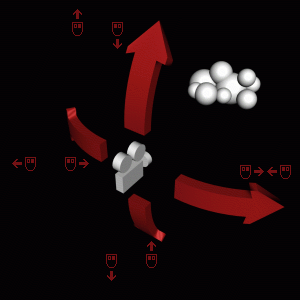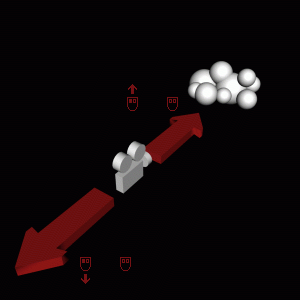2-Handed Camera Navigation: A Sketch
A 2-handed interface is described in [1] where the non-dominant hand
controls the camera view while the dominant hand manipulates the scene.
Here, a scheme is described where both hands control the camera view.
Most traditional camera navigation schemes fall into one of two
categories: (A) free floating/flying metaphors, where the camera is
suspended in space and can be moved or flown in any of 6 perpendicular
directions or pitched/yawed/rolled; and (B) object-centric metaphors,
where the camera orbits around a fixed center or "point of interest".
Scheme A is well suited for exploring the interior of a scene or
structure, whereas B is better for quickly viewing an object or
scene from any outside point. Changing the "point of interest" in B can
typically be done with a "look at" tool, or by panning (OpenInventor's
ExaminerViewer, for example, supports both of these). However,
attempting to move through a 3D architectural model with scheme B
is at best cumbersome.
I propose a bimanual implementation of scheme A that can be used
to quickly orbit around any region of interest, much like in scheme B.

| 
|
| The non-dominant hand controls panning.
| The dominant hand controls pitch and yaw.
|

|
| Coordinated motion by both hands will orbit
the camera around a region of interest.
Unless hand motions are very precise, the point of interest
will not stay exactly fixed. Experimentation is required
to determine if this is a significant problem.
|

| 
|
| Using a secondary button,
the non-dominant hand can also dolly.
| Similarly, the dominant hand can
control roll with a secondary button.
|
Postscriptum: After reading this proposal, Balakrishnan directed me
to [2], which proproses some alternative schemes for bimanual
camera control.
Post-postscriptum: (January 2003) Another
bimanual technique for camera navigation is described by
Mine et al. [3] -- the technique seems to use a "witch's broom" metaphor.
Furthermore, it has come to my attention that many games
(for example, Sierra's Counter-Strike, and possibly Doom as well)
use a bimanual camera navigation
interface, where the keyboard is used for translation
(e.g. keys D, A, W, S translate right, left, forward, and back
respectively) and the mouse is used for rotation
(e.g. for yaw and pitch). Although play is usually constrained
to a horizontal plane, pitch is useful for looking up and down,
and in Counter-Strike, after dying, the player can actually
fly upward/downward (to look at other players)
by pitching and translating simultaneously.
| [1]
| Balakrishnan and Kurtenbach,
Exploring Bimanual Camera Control and Object
Manipulation in 3D Graphics Interfaces,
in Proceedings of CHI '99, ACM, pages 56-63.
|
| [2]
| Zeleznik, Forsberg, and Strauss,
Two Pointer Input for 3D Interaction,
in Symposium on Interactive 3D Graphics, 1997,
ACM, pages 115-120.
|
| [3]
| Mine et al., "Moving objects in space: exploiting proprioception
in virtual-environment interaction", SIGGRAPH '97
|
Copyright ( C ) Michael McGuffin
September 11, 2000
Updated January 2003




